Physical Address
304 North Cardinal St.
Dorchester Center, MA 02124
The skin is a complex microenvironment. The normal structures of the epidermis, dermis, and cutaneous adnexa are morphologically and functionally complicated, and the histologic entities that occur in this tissue compartment are also numerous. Furthermore, cutaneous lesions may also be a part of systemic proliferations, or they may have exact morphologic counterparts in other sites. Principal examples of such disorders are hematolymphoid diseases and mesenchymal tumors. Since the immunohistochemical (IHC) features pertaining to those conditions are covered in detail elsewhere in this text, comments on this chapter are relatively limited in scope, mainly centering on lesions peculiar to the skin. Finally, as with melanocytic lesions of the skin (see Chapter 7 ), this chapter primarily focuses on antigenic profiles that can be obtained with routinely processed, formalin-fixed tissues and commercially available reagents.
The many forms of differentiated epidermal and adnexal epithelia in the skin result in a potentially confusing nosologic categorization. Despite that diversity, most lesions can be grouped under five basic patterns of differentiation: (1) epidermal, (2) sweat glandular (eccrine and apocrine), (3) sebaceous, (4) follicular, and (5) endocrine. However, not all lesions can be easily classified in these five groups. As an example, the clear-cell carcinoma with comedonecrosis is a neoplasm characterized by an aggressive course (local recurrence or distant metastasis) with features that resemble squamous cell carcinoma (SCC), sebaceous carcinoma, and eccrine carcinoma. Reflecting this morphologic diversity, this lesion expresses IHC features of those three lesions, including cytokeratins 5 and 6 (CK5/6), the same as in SCC; epithelial membrane antigen (EMA) and CK17 in the clear cells, as in follicular structures or sebaceous carcinoma; and focal carcinoembryonic antigen (CEA) expression, as in eccrine carcinoma. Cases like this one are best classified as “adnexal,” and then the types of differentiation that they contain may be indicated in the diagnosis.
Tumors with differentiation toward epidermal cells are the most common epithelial neoplasms of the skin. The most important of these are SCC and basal cell carcinoma (BCC). Furthermore, BCC is the most common malignancy in humans.
SCC is usually composed of polygonal cells with nuclear atypia and diverse degrees of keratinization, either in the epidermis (in situ) or invasive, and thus it is usually easy to diagnose. However, several microscopic subtypes of SCC may occasionally mimic both glandular and mesenchymal neoplasms in skin. These include adenoid (acantholytic), pleomorphic, small cell, and spindle cell forms. Due to the latter variants, an understanding of the immunohistologic attributes of SCC is important to the differential diagnosis of cutaneous tumors in general. Fortunately, all forms of SCC show similar antigenic profiles.
SCC contains an abundance of cytokeratin (CK) intermediate filament proteins that range from 40 to 68 kD in molecular weight. The more well-differentiated cells synthesize high-molecular-weight (HMW) CK; in contrast, poorly differentiated tumors usually only express low-molecular-weight (LMW) keratin peptides. The concomitant expression of both CK and vimentin characterizes spindle cell, pleomorphic, and some acantholytic SCCs and metastatic renal cell carcinomas (RCCs; Fig. 13.1 ).
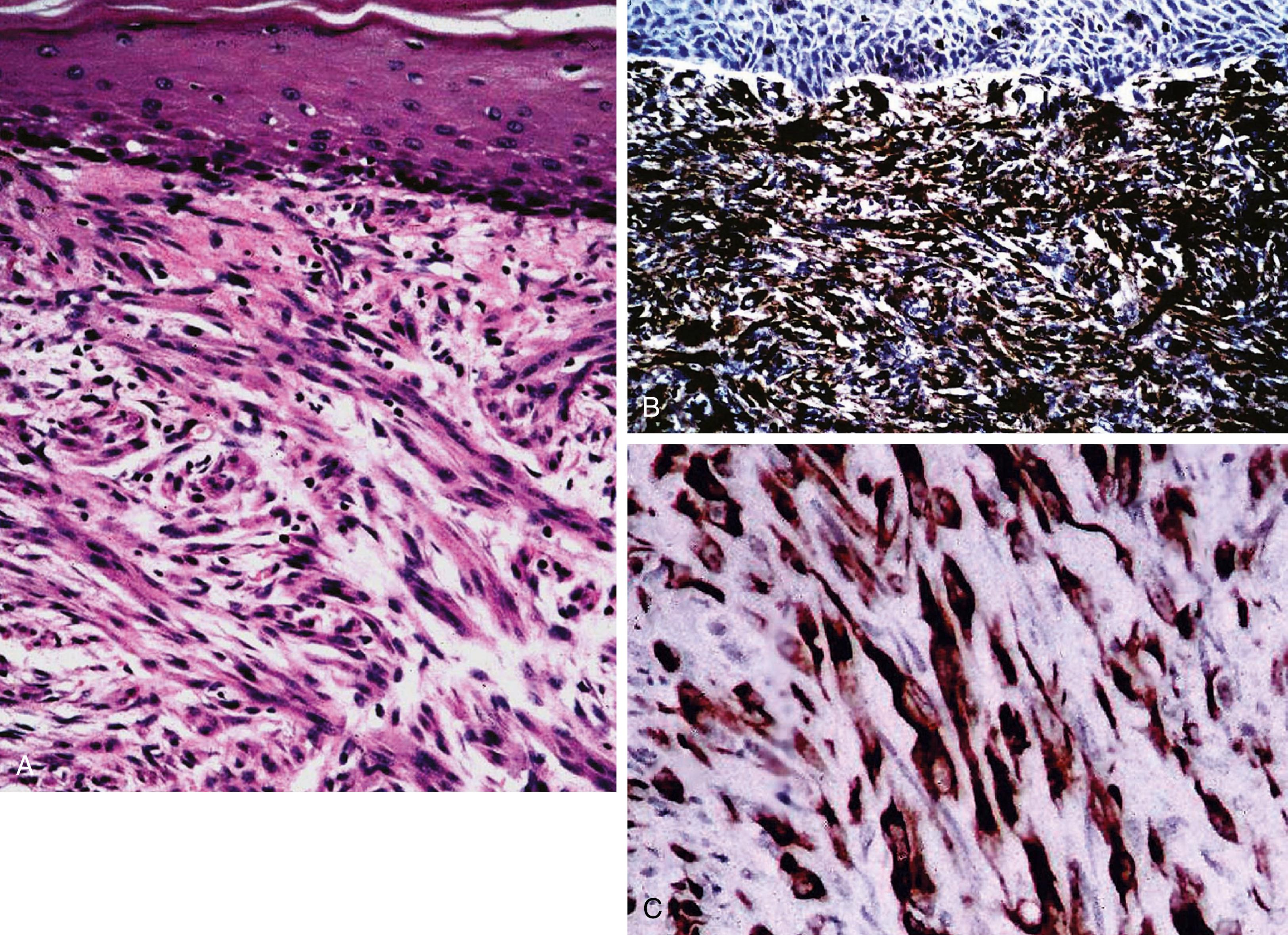
Sarcomatoid carcinomas may sometimes express keratin only focally, and the best approach to their recognition is to use a broadly reactive mixture of monoclonal antikeratin as a screening reagent. CK5/6 could be included as specific targets therein, because these CKs are more selective for squamous differentiation.
Another antigen displayed in SCC is EMA. Although variable amounts of this glycoprotein are encountered in most examples of SCC, diffuse expression of EMA is usually seen only in poorly differentiated lesions.
CEA staining has been described in SCC, but in our experience, diffuse reactivity is rare. Also, p63 protein is a nuclear determinant associated with both myoepithelial and epithelial differentiation, and it is seen in squamous, basal cell, and appendageal cutaneous carcinomas ( Fig. 13.2 ). It is a member of the p53 family, which includes the p53, p40, p63, and p73 polypeptides.
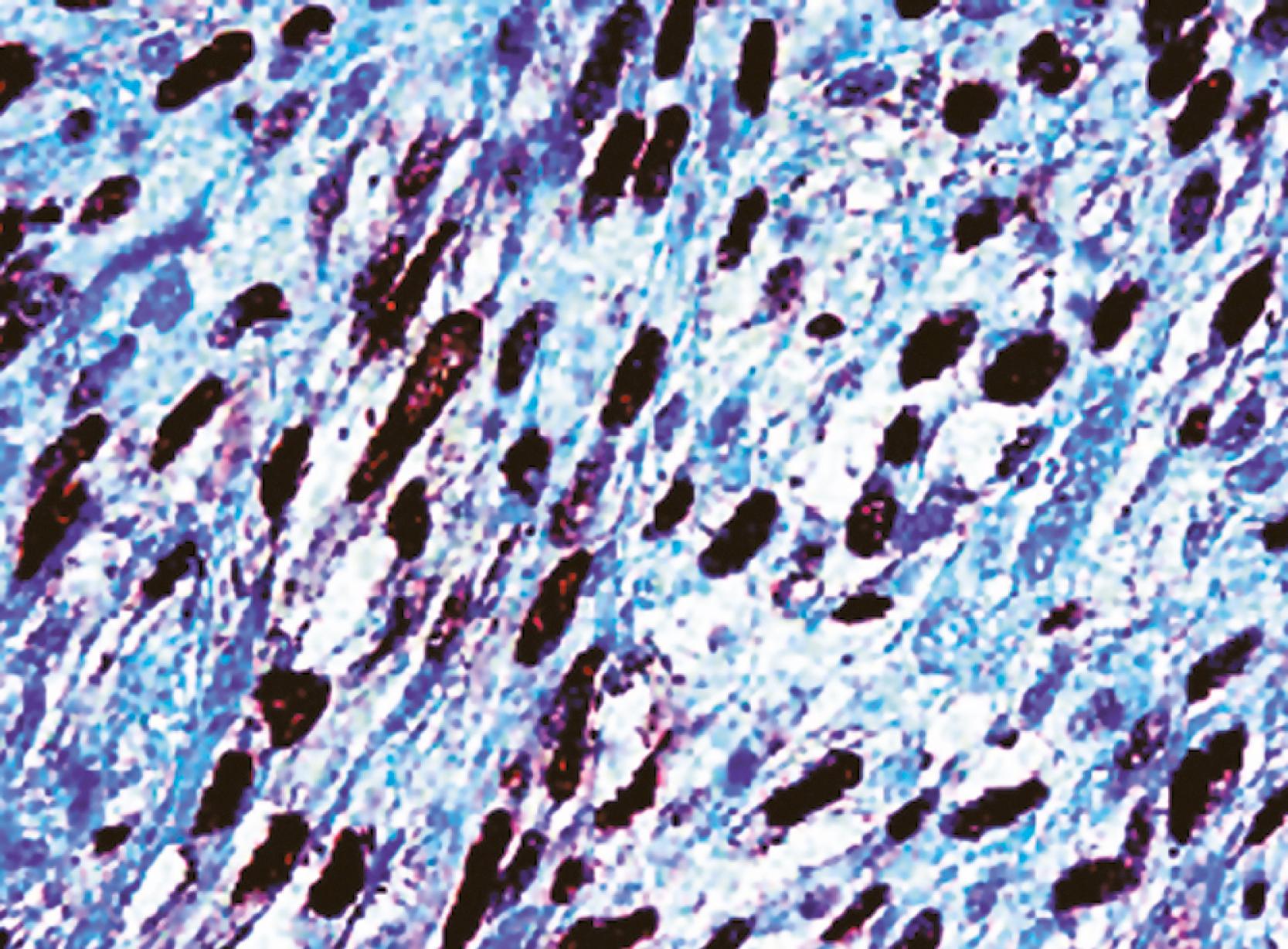
SCCs of the skin lack S100 protein, chromogranin, synaptophysin, CD99, CD15, and CD57. Further, reactivity with human melanoma black 45 (HMB-45) or anti-melan-A is consistently absent, as are desmin and muscle-specific isoforms of actin in most spindle cell forms of these neoplasms.
There are no well-characterized proteins that exclusively define malignant epidermal differentiation. It has been suggested that Bcl-2 and molecules associated with epidermal keratinization, such as filaggrin and involucrin, are preferentially expressed in SCC but can also be seen in keratoacanthomas and a variety of benign keratinocytic proliferations. Although they may help distinguish SCC from BCC, those markers cannot separate SCC from adnexal tumors of the skin, particularly those of pilar differentiation.
Among the current field of applications of targeted therapies to some neoplasms, there are several targets that may become useful in the management of cutaneous SCCs. SCCs with aggressive phenotype express leptin receptors (LEPRs) and thus might be treated with LEPR antagonists. Similarly, expression of ring finger protein 2 (RNF2) correlates not only with aggressive histologic features, but also with decreased disease-specific survival. Anti-PD-L1 and anti-CTL4 medications have shown effectiveness in advanced SCC. ,
Adenoid (acantholytic), pleomorphic, small cell, and spindle cell forms are variants of SCC that may mimic other lesions.
SCC is labeled with AE1/AE3, 34βE12, and CK5/6.
Less differentiated SCC is labeled with CAM5.2, AE1/AE3, and anti-p63 and p40.
In general, SCC is EMA, p63, and CD44 positive and BerEp4 negative.
In general, BCC is EMA negative and BerEP4 positive.
Current clinical trials require IHC evaluation of potential targets such as PD-1 and PD-L1.
BCC, as with SCC, has several distinctive variants, all of which invoke dissimilar differential diagnoses. Among the better-recognized subtypes of BCC are the morpheaform, adenoid, clear cell, hamartomatous (also referred to as infundibulocystic ), and metatypical forms (i.e., with extensive squamous differentiation). Of all the subtypes, the ones associated with high rates of recurrence are those associated with an irregular, infiltrative border (sclerodermoid, morpheaform, and infiltrative); small nest size (micronodular); extensive squamous differentiation; and eccrine differentiation.
In general, BCC lacks complex patterns of antigenic expression. As for SCC, this tumor displays reactivity for CK polypeptides; however, the molecular weight of these intermediate filaments is typically less than 50 kD. In contrast to SCC, EMA is not observed in any variant of pure BCC ( Fig. 13.3 ).

Occasionally, BCC (and SCC) can contain “passenger” melanocytes, and such cells will express melan-A and HMB-45 antigens. Similarly, a few lesions exhibit staining for endocrine-associated peptides, including CD56, synaptophysin, and chromogranin A (CG). , The apparent ability of BCC to express such specialized determinants has been used to support the premise that the cells of that lesion recapitulate the properties of epidermal “stem” cells. Nevertheless, the absence of vimentin, CEA, S100 protein, CD57, and CD15 suggests that there may be flaws in this “stem cell hypothesis” as applied to BCC. Indeed, BCC with additional patterns of differentiation such as “eccrine epithelioma,” “apocrine epithelioma,” and so-called basosebaceous epithelioma may show positivity for EMA, CEA, or CD15 in histologically divergent areas. Also interesting is the reduced smooth muscle actin (SMA) expression in some BCCs associated with an aggressive behavior.
Another useful glycoprotein marker present in most BCCs is recognized by the antibody BerEP4, directed at two epitopes, 34 kD and 39 kD, on human epithelial cells ( Fig. 13.4 ). In the skin, BerEP4 labels not only BCCs, but also the cells of Paget disease, Merkel cell carcinoma (MCC), and other selected appendageal neoplasms. It is probably most useful in separating BCC with squamous differentiation from basaloid SCC, which is BerEP4 negative. Conversely, squamous tumors bind to the L-fucose-specific lectin, Ulex europaeus I, which is usually negative in BCC. The distinction between basaloid SCC and BCC is diagnostically crucial in certain anatomic locations, such as the anal and perianal skin, because the former has a much worse prognosis.
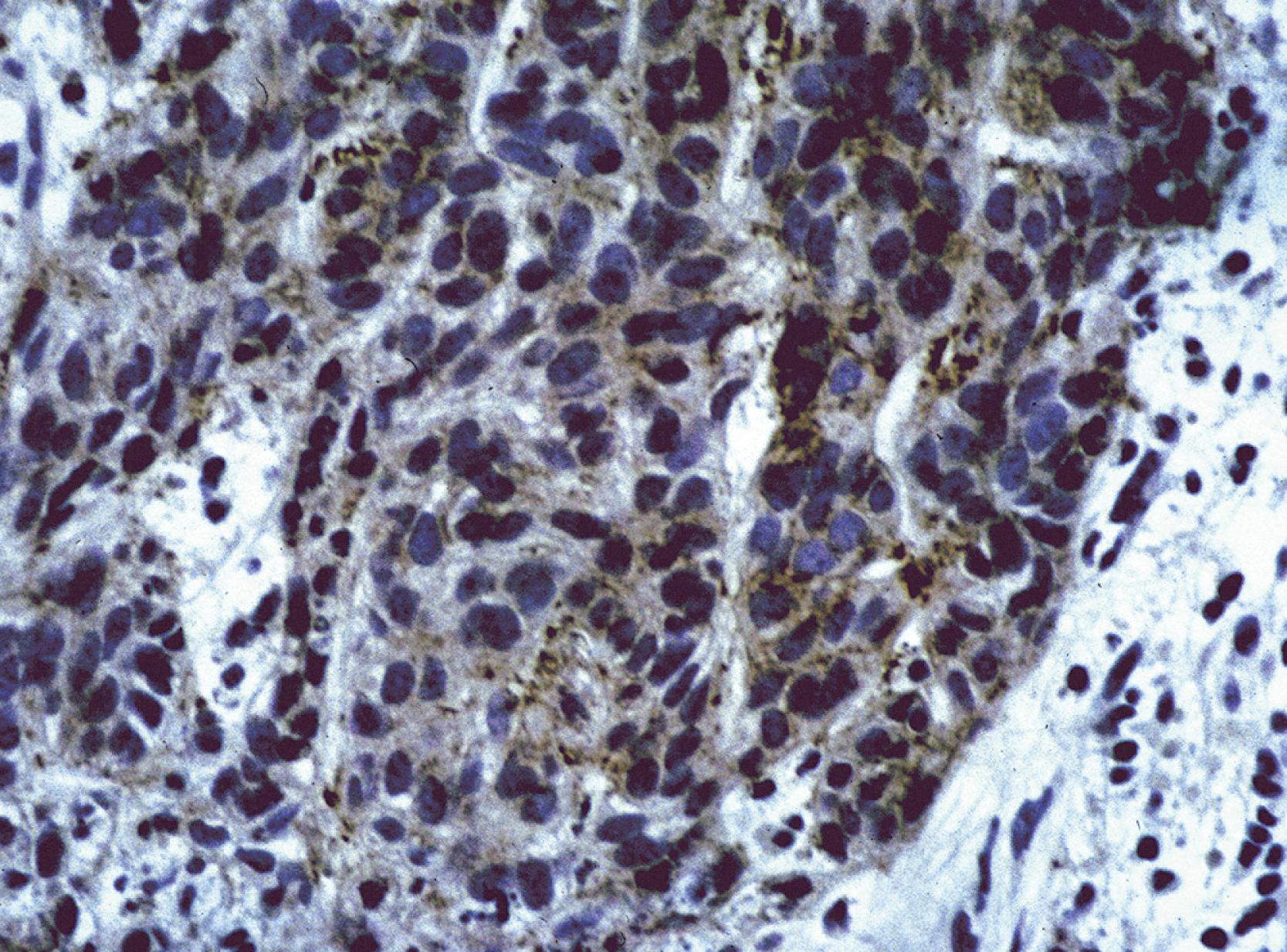
The eccrine and apocrine glandular adnexa comprise the sudoriferous structures of the skin. The neoplasms of these structures are histologically diverse but share certain immunohistologic features. , All of these tumors demonstrate CK reactivity and the potential for expression of CEA, tumor-associated glycoprotein 72 (TAG-72, also known as CA72.4; Fig. 13.5 ), EMA, CD15, and p63. The last three of these substances are seen in varying proportions in both adenomas and carcinomas. Also reflecting the presence of myoepithelial cells in some adnexal neoplasms, SOX10 can be detected in most eccrine and apocrine lesions, although it tends to be negative in syringoma and microcystic adnexal carcinoma (MAC). EMA is more often observed in malignant sudoriferous neoplasms than in benign ones; indeed, spiradenoma and cylindroma typically lack this determinant. In contrast, CEA and CD15 are detected in roughly 70% to 80% of all eccrine and apocrine lesions, regardless of their biological potentials; TAG-72 appears to show a predilection for apocrine lesions and is usually not seen in eccrine tumors. This profile proves useful in the separation of sudoriferous neoplasms from other cutaneous glandular and epidermal neoplasms. It has also been instrumental in verifying the presence of sweat glandular differentiation in occasional examples of lymphoepithelioma-like carcinoma of the skin—a poorly differentiated tumor that shows histologic similarities to nasopharyngeal lymphoepithelioma.
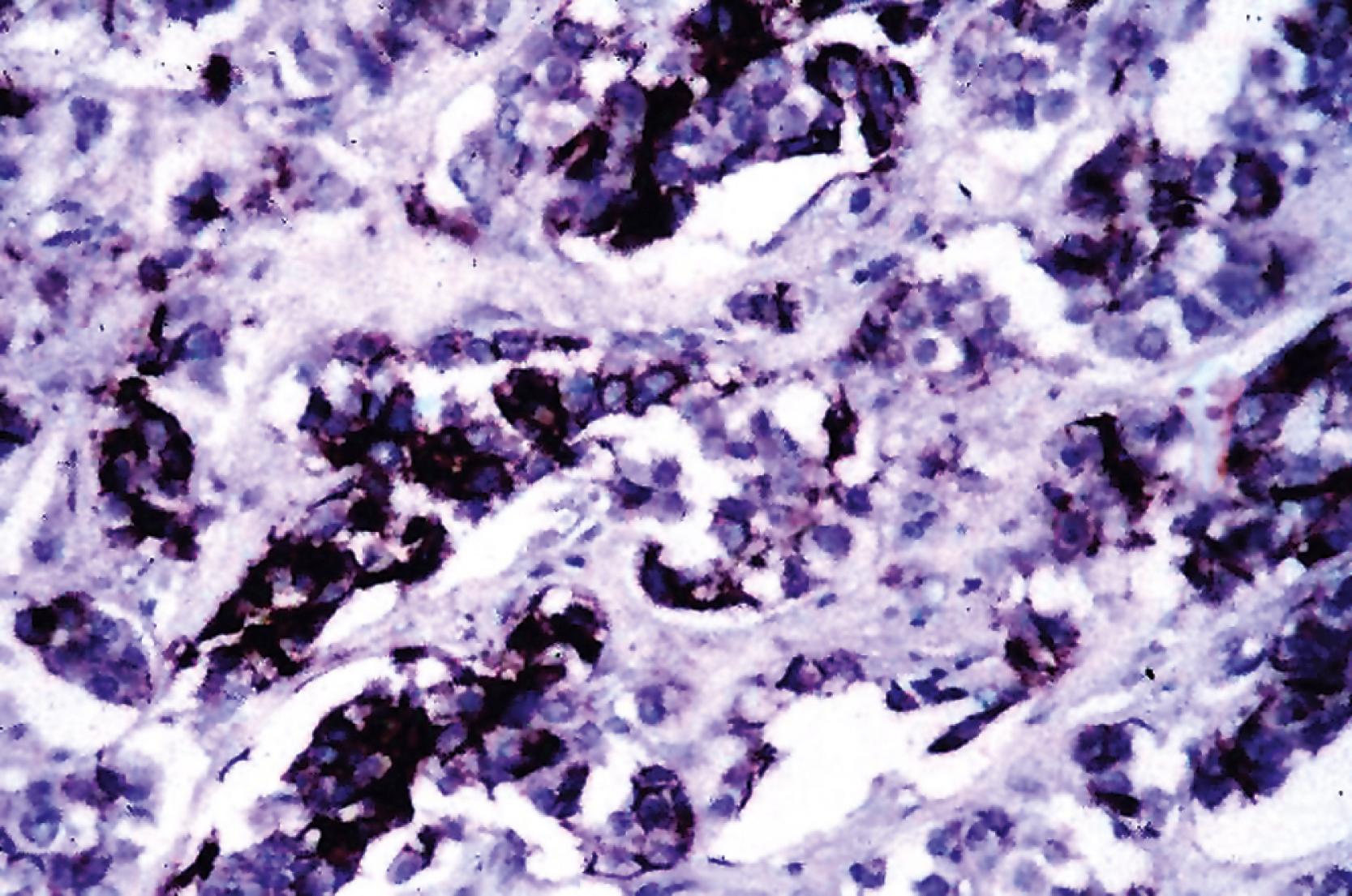
Immunophenotypic differences between eccrine and apocrine neoplasms may occasionally be exploited to diagnostic advantage. For instance, eccrine carcinomas express S100 protein in almost 50% of cases, whereas apocrine carcinomas, including invasive extramammary Paget disease (EMPD), are generally negative for that marker. Conversely, the mammary antigen gross cystic disease fluid protein 15 (GCDFP-15) and androgen receptors (ARs) are commonly expressed by cutaneous apocrine cells and their neoplasms ( Fig. 13.6 ), , , along with TAG-72. Some studies have described the selective expression of specific CK peptides and other antigens in either eccrine or apocrine lesions. Antibodies to EKH5, EKH6, and IKH-4; chondroitinase ABC-sensitive anionic sites, detected by cationic gold at pH 2.0 after pretreatment with ethylene glycol tetraacetic acid (EGTA); and intercellular canaliculi with high activity of alkaline phosphatase are reportedly specific for eccrine differentiation, whereas antibodies to 70-kD glycoprotein purified from human milk fat globule (HMFG) membranes and HMFG-1 antigen (1.10.F3, against defatted HMFG membranes) would be present only in apocrine cells.
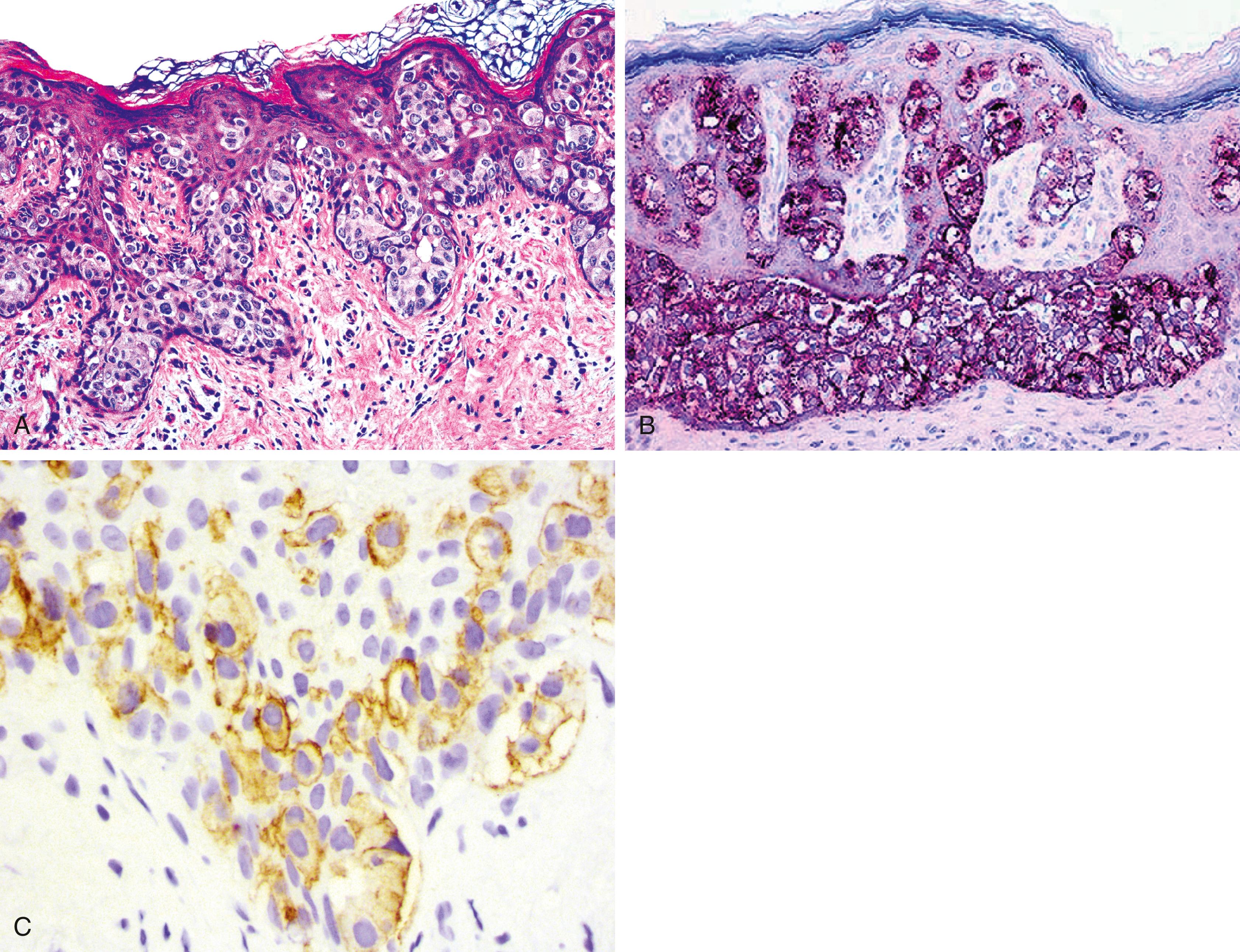
GCDFP-15, CA72.4, ARs, CK7, CD23, and BerEP4 can separate EMPD from melanoma and pagetoid SCC—that is, intraepidermal squamous carcinoma with pagetoid migration that resembles Paget disease and melanoma—because they are present only in the first of those three tumors. , In contrast, SCC expresses HMW keratin, whereas melanoma reacts with HMB-45, melan-A, and antibodies to S100 protein in this group of lesions (see Chapter 7 ). In EMPD, there seems to be a differential expression of mucin core proteins (MUCs), because intraepidermal EMPD shows expression of MUC1 and MUC5, whereas the latter is lost in invasive EMPD. CK subtyping can also help, because primary vulvar EMPD usually expresses CK7 and GCDFP-15, whereas EMPD secondary to anorectal carcinomas usually expresses CK20. Furthermore, EMPD secondary to urothelial carcinoma expresses CK7, CK20, and uroplakin III, but not GCDFP-15.
Alpha-methylacyl-Co-A-racemase (AMACR) reactivity has been observed in EMPD, as well as in SCC and melanoma. Therefore, it has less diagnostic value compared with the aforementioned antigens. Also, highlighting the similarities between sweat gland tumors and mammary carcinomas, EMPD can express ERBB2 (formerly Her2/neu), a fact that may be exploited for therapeutic purposes (see Fig. 13.6 ). , ERBB2 expression may also be useful to distinguish between Paget disease and intraepidermal Toker cells, because the latter tend to be negative.
One difficulty in the diagnosis of sweat gland carcinoma is its distinction from metastatic adenocarcinoma in the skin, although the best way of achieving that goal is still by paying attention to the clinical history. Primary adnexal tumors are typically solitary and slowly growing (present for at least 6 months), whereas metastases tend to be multiple and to evolve rapidly. Also, p63 reactivity may be helpful, , because expression of p63 by more than 25% of tumor cells has been observed in the majority of sweat gland and apocrine carcinomas, both primary and metastatic, but it has not been seen in metastatic adenocarcinomas. However, a possible pitfall with p63 is that it will be expressed in squamous and urothelial neoplasms, and therefore p63 expression will be useful in cases of glandular differentiation (adenocarcinoma). Additional markers that may contribute to the separation of primary and secondary carcinomas in the skin are calretinin, CK5/6, and podoplanin. , As with p63, these antigens are mainly seen in primary cutaneous appendage tumors and not in adenocarcinomas metastatic to the skin ( Fig. 13.7 ). Although GATA3 is commonly expressed in breast carcinomas, it can also be detected in a number of cutaneous adenocarcinomas. Therefore, its usefulness in this differential diagnosis is limited.
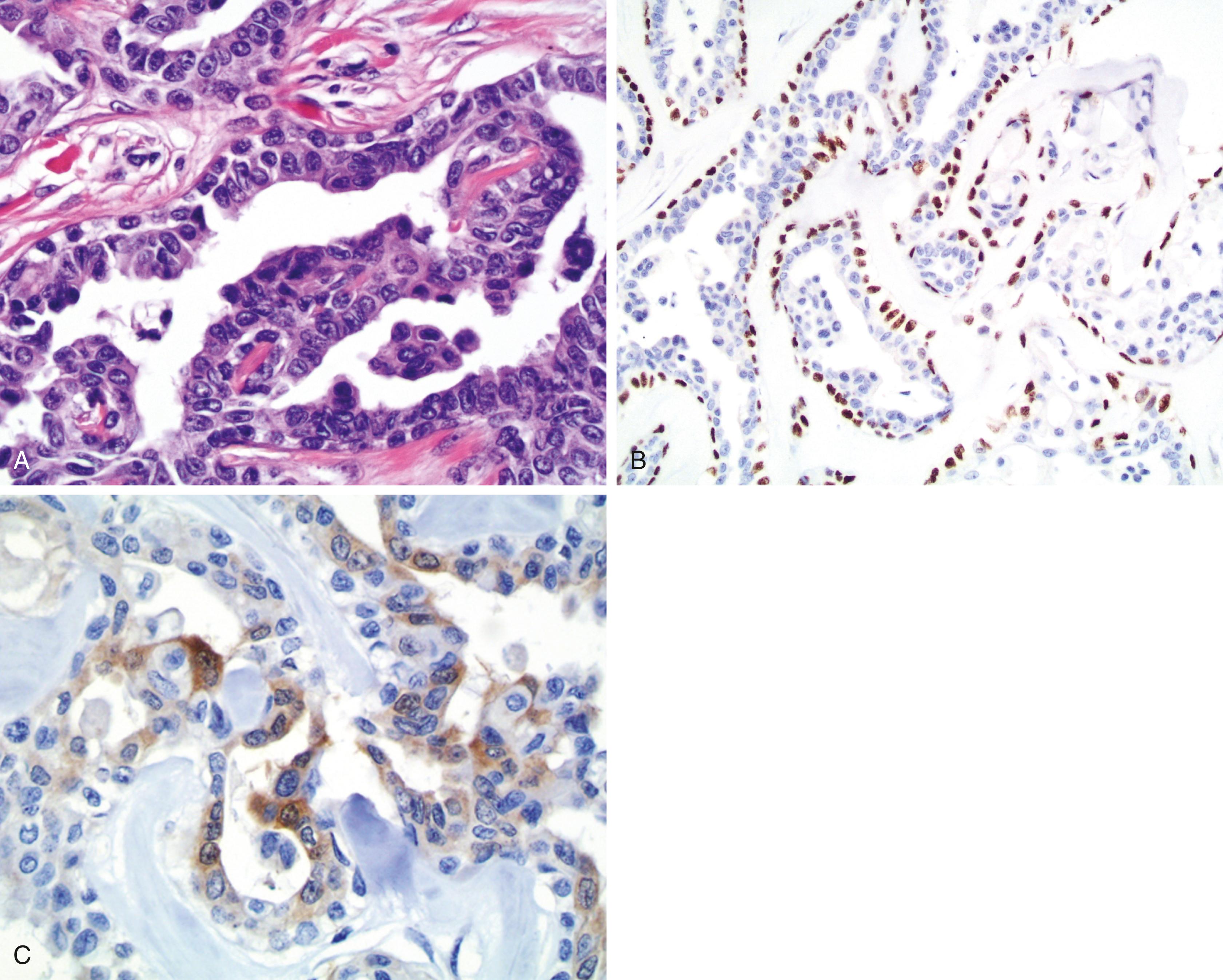
Cutaneous cribriform carcinoma is a relatively recently described apocrine neoplasm with relatively low malignant potential. In contrast with most sweat gland and sebaceous tumors, the cribriform carcinoma does not express GATA3, and as such, this marker may help its differentiation with breast carcinoma.
Squamoid eccrine ductal carcinoma is an adnexal neoplasm with capability for local recurrence and metastasis that shows both ductal and squamous differentiation. It shows a predilection for the head and neck in elderly males. The upper portion resembles well-differentiated SCCs, while the deeper areas show glands infiltrating a desmoplastic stroma. Most of the cells express p63 (both squamous and ductal) while being negative for ber-ep4. The ducts express CEA and EMA while being negative for GCDFP15 or CK20. PHLDA1, the marker mostly associated with follicular differentiation, is described as positive mainly in the deepest parts of strands, slightly positive in nests.
Sweat gland tumors express keratin, CEA, CA72.4, CD15, GATA3, podoplanin, calretinin, and p63. The latter may be helpful in distinguishing cutaneous adnexal carcinomas from adenocarcinomas metastatic to the skin.
EMA is more common in malignant neoplasms.
Eccrine carcinomas are S100 positive, but apocrine are S100 negative. Both are positive for GCDFP-15, estrogen receptors, p63, podoplanin, and calretinin. The latter four ones may help in the differential diagnosis with breast carcinoma.
Paget disease is positive with CK7, GCDFP-15, BerEP4, and CA72.4; some secondary forms of extramammary Paget disease are CK20 positive.
Although it is a glandular adnexal structure, the sebaceous gland is topographically and ontogenetically related to the hair sheath, hence the similarities between the isthmus of the outer hair sheath and germinative basaloid cells of the sebaceous gland. Also, there may be lesions with both basosebaceous and hair sheath elements (as in, epithelioma with sebaceous differentiation and sebaceous epithelioma, also called sebaceoma) or the finding of melanocytes in both follicular and sebaceous lesions. Thus, in contrast to most eccrine or apocrine tumors, pilar and sebaceous neoplasms commonly express both HMW and LMW keratins, including CK17. Many antigens associated with sweat gland tumors—including S100 protein, CA72.4, GCDFP-15, and CEA—are absent in sebaceous neoplasms.
Reactivity for EMA and related substances is often obtained in sebaceous tumors. In both benign and malignant sebaceous proliferations, a characteristic microvesicular, or “bubbly,” cytoplasmic profile of mature sebocytes results in scalloping of a central nucleus ( Fig. 13.8 ). It is important to remember that this morphologic change (scalloping), albeit very useful, is not diagnostic of sebaceous differentiation because it can be seen also in adipocytes and balloon-cell melanocytes. EMA expression in sebaceous neoplasms is comparable with that seen in nonneoplastic sebaceous epithelium, in that cytoplasmic lipid vesicles are rimmed by EMA reactivity. Another marker that is fairly specific to sebaceous differentiation is adipophilin, a marker seen in the lipid vacuoles characteristic of adipocytes. However, because positivity with anti-adipophilin can be seen in other vacuoles in macrophages, to consider that this antibody indicates sebaceous differentiation, it must label the membrane of the vacuoles (see Fig. 13.8 ). Another marker, perilipin, has recently been reported in sebocytes (IHC staining for adipophilin, perilipin, and TIP47), and thus perilipin is also helpful in detecting sebaceous differentiation.
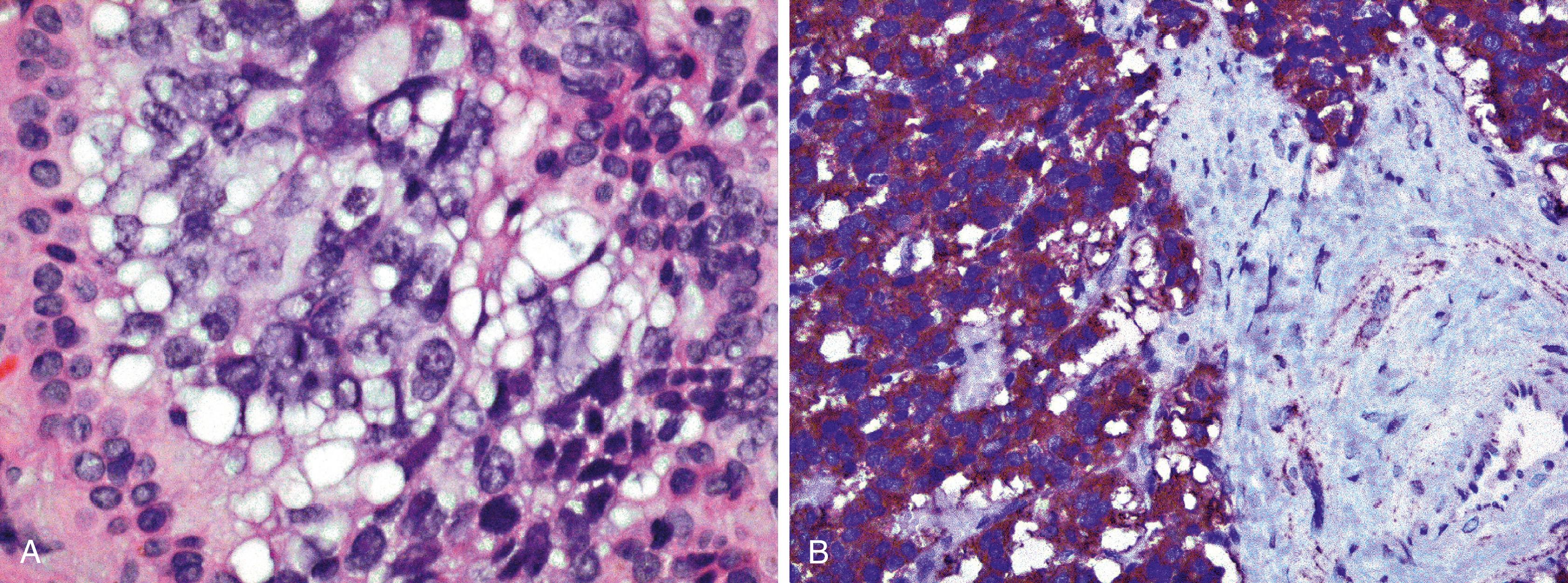
Other diagnostically relevant determinants shared by sebaceous and sweat gland neoplasms are CD15 and BerEP4. , However, an antibody panel directed at EMA, S100 protein, adipophilin, and CEA should allow for separation between those tumors. In addition, Bayer-Garner and colleagues found that all sebaceous tumors were reactive for ARs, whereas Shikata and colleagues suggested that sebaceous carcinomas lacked such expression.
The pathologic distinction between primary sebaceous carcinoma and metastatic RCC is important because both lesions share a clear cell appearance. Slow evolution of a solitary skin tumor favors a primary lesion. In addition, podoplanin and adipophilin are effective in this context: Both are consistently present in sebaceous tumors, whereas they are absent in RCC. , CD10 is potentially seen in both lesion categories. , PAX8 is also expected to be expressed in clear-cell RCC.
Some of the sebaceous lesions (mostly sebaceous adenoma, sebaceoma, sebaceous carcinoma, and a number of BCCs with sebaceous differentiation) may be associated with Muir-Torre syndrome. In some institutions, including ours, IHC may be used as a screening tool to try to diagnose Muir-Torre syndrome. The sebaceous lesions more likely to be associated with Muir-Torre syndrome are those occurring below the neck or else with large cystic areas or keratoacanthoma-like morphology. In such cases, we perform a panel of antibodies against MLH1, PMS2, MHS2, and MSH6. If any of the four is lost (with MSH2/MSH6 being the most common), then the patient may be considered for genetic screening.
Some authors recommend the study of all cutaneous sebaceous lesions, regardless of location or morphology, yet others consider that IHC in this setting is not helpful.
There is no significant expression of S100 protein, CA72.4, GCDFP-15, or CEA in sebaceous tumors, compared with sweat gland tumors, which are positive for these markers.
Sebaceous and sweat gland tumors are CD15- and BerEP4-positive.
EMA and adipophilin are positive. Adipophilin should be seen in the membrane of the cytoplasmic vacuoles to be considered positive.
Sebaceous lesions, particularly those below the neck or with cystic areas or keratoacanthomatous pattern, may be examined with IHC to detect possible losses of microsatellite enzymes and to help in the diagnosis of Muir-Torre syndrome.
The multiplicity of diagnoses assigned to benign pilar tumors reflects the multiple morphologic manifestations of trichogenic differentiation. Unfortunately, most commercially available antibodies fail to select among those various patterns, including lesions with features of the germinal matrix, cortex, inner hair sheath, outer hair sheath, and infundibulum. Indeed, the antigenic profiles of all benign pilar tumors are generally similar—they typically contain BerEP4 antigen, p63, and CK polypeptides more than 50 kD in molecular weight, including CK17. , However, except for occasional proliferating pilar tumors, trichogenic neoplasms are EMA-negative. CEA, S100, CD15, CA72.4, the HMB-45 antigen, and GCDFP-15 are also usually not expressed in these tumors. As such, the immunophenotype of pilar tumors is generally similar to that of BCC.
Regarding the differentiation between trichoepithelioma (TE) and BCC, several studies have indicated IHC differences between the two. In BCC, Bcl-2 protein is expressed with a diffuse pattern ( Fig. 13.9 ) of the epithelial cells, whereas CD34 is expressed in the peritumoral stromal cells of TE. , Moreover, Lum and Binder found that a Ki-67 index of greater than 25% and p21 protein expression were also discriminatory, and both favor a diagnosis of BCC. In contrast, other authors have indicated that IHC is not very helpful in this differential diagnosis. Since both TE and BCC are neoplasms with putative differentiation toward follicular structures, it is likely that IHC cannot absolutely differentiate every case. Furthermore, we recently reported our experience in trying to separate TE from a type of BCC that has advanced follicular differentiation (hamartomatous/infundibulocystic). As expected, these tumors share many features, but expression of CK20-positive cells (Merkel cells) and CD10-positive stromal cells is more frequent in TE, whereas BCC expresses CD10 in the basaloid cells. Similarly, another marker predominantly expressed in follicular lesions is PHLDA1, which is also focally positive in BCC with follicular differentiation. , A recent study suggests that the combination of Bcl-2 and AR is very helpful, since most BCCs express AR and, diffusely, Bcl-2, while TE tends to be negative for AR and shows only scattered Bcl-2–positive cells.
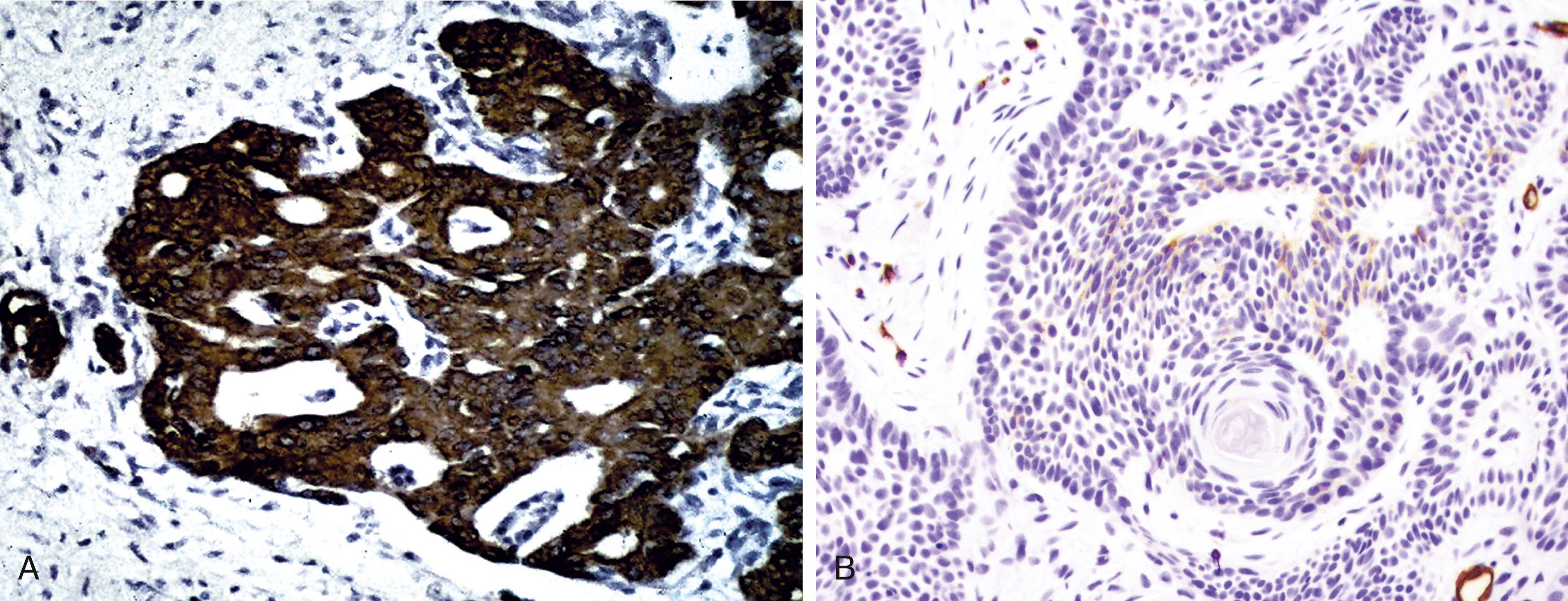
Three lesions that may be very similar histologically are desmoplastic trichoepithelioma (DTE), infiltrative BCC (IBCC), and MAC. The epithelial cells in DTE more often show EMA positivity than in IBCC and frequently show neuroendocrine (Merkel) cells with chromogranin A and anti-CK20, as mentioned earlier ( Fig. 13.10 ). , Peritumoral stromal cells are reactive for stromelysin-3, a proteolytic enzyme, in IBCC but not in DTE, and the ducts in MAC will express CEA in their lumina. , AR-positivity can be seen in BCC but is negative in most DTEs. Similarly, Laminin (Ln)-gamma 2 (a chain of Ln-332) is preferentially expressed in both infiltrating BCC and MAC while being negative in DTE and syringoma. As such, its IHC analysis has been suggested to distinguish between those benign and malignant cutaneous lesions with desmoplastic stroma.
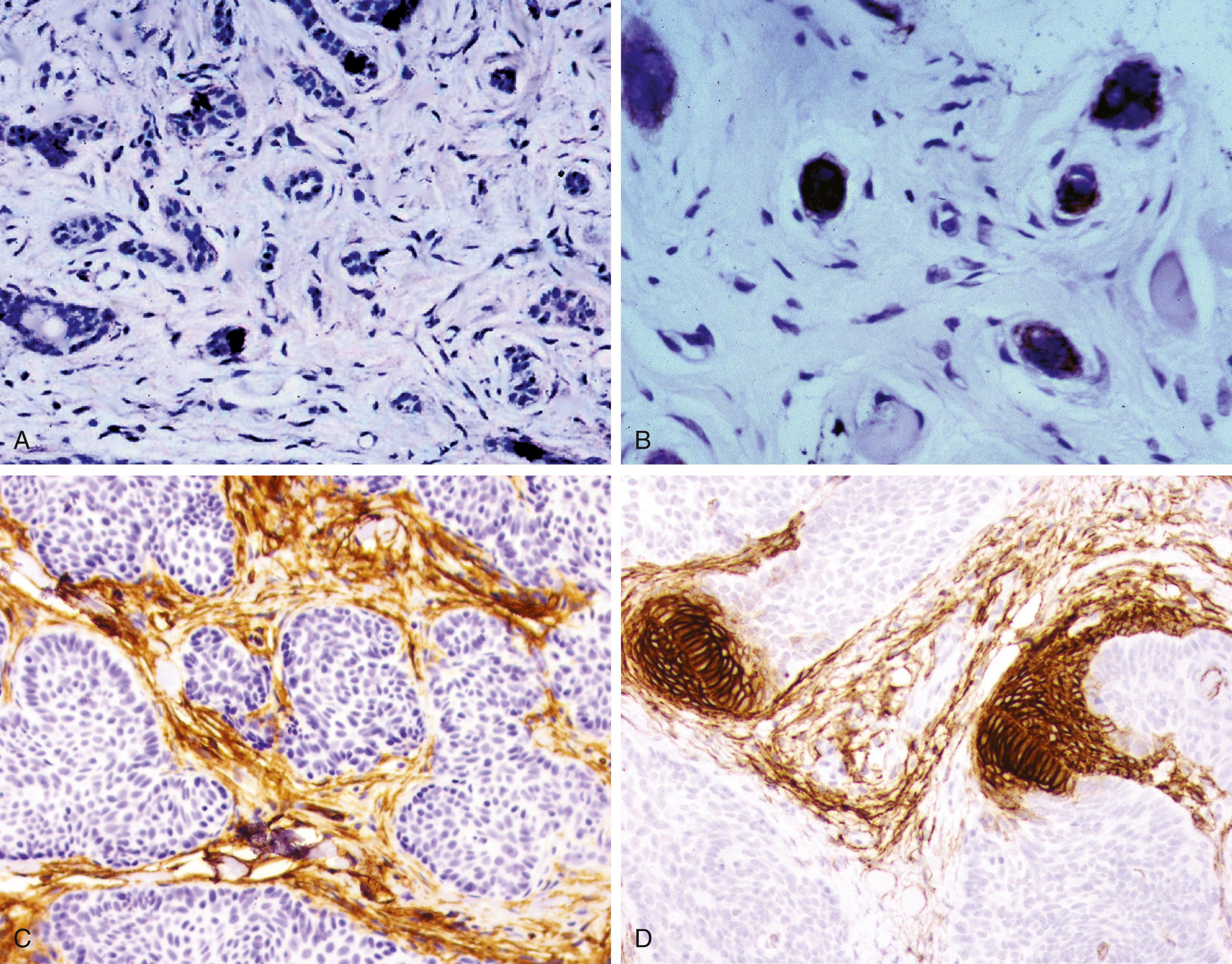
The “hard keratins” recognized by the antibodies AE12 and AE13 are selectively expressed in cells that exhibit matrical differentiation. Pilomatricoma is diffusely reactive with AE13, whereas diminutive or abortive hair follicles represent the only reactive population in trichofolliculoma. Tumors with trichilemmal patterns of differentiation, proliferating pilar tumor and trichilemmoma, are negative with AE13 but usually react with AE14 ( Fig. 13.11 ), a monoclonal antibody that recognizes both a cortical sulfur-containing moiety and an LMW CK. The latter keratin is typically expressed by most adnexal epithelia and epidermal basal cells. The small keratotic cysts in DTE are AE13-positive, whereas examples of classic TE are reportedly negative. Consistent AE13 labeling is also seen in the small keratin cysts of MAC, indicating partial pilar differentiation in that tumor ( Fig. 13.12 ).
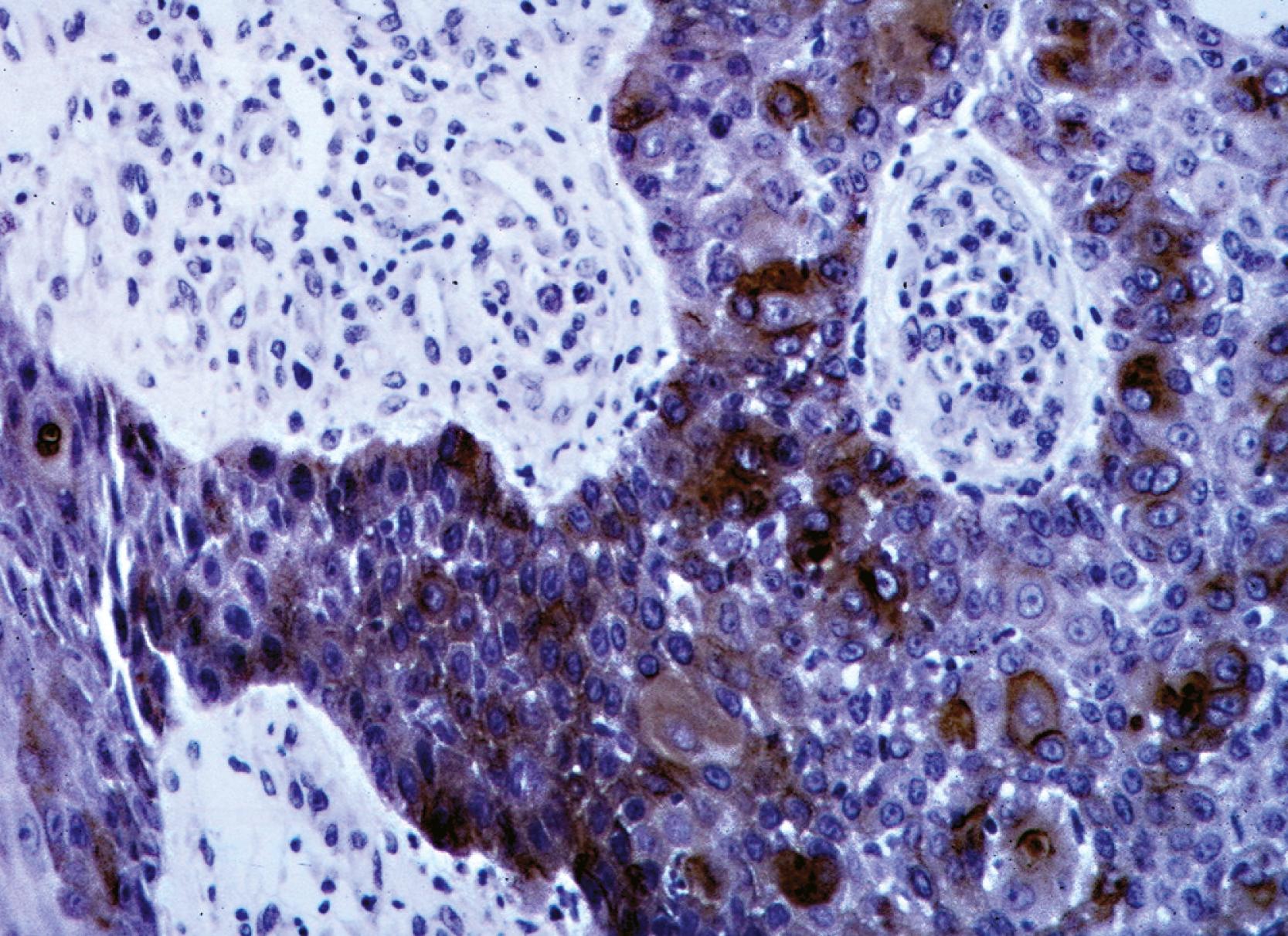
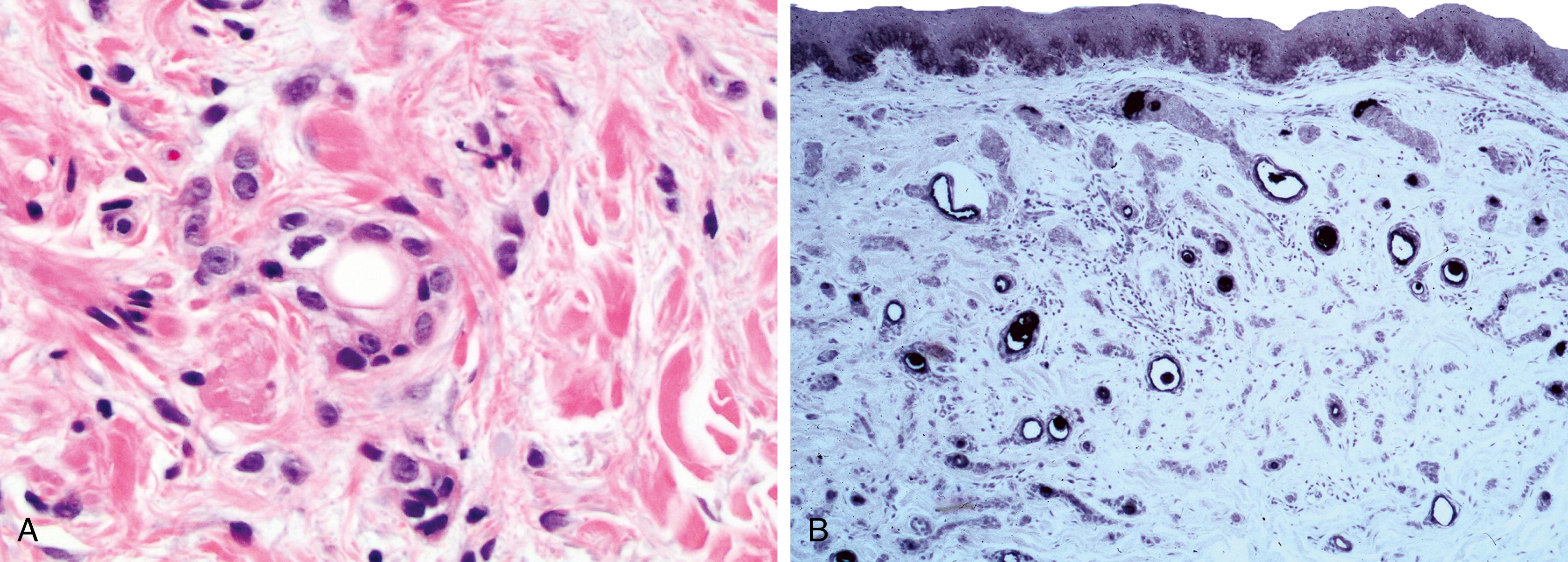
The expression of keratin proteins labeled by the anti-hair keratin (HKN) antibodies—HKN5, HKN6, and HKN7—and anti-human hair keratin (HHK) probably reflects specialized patterns of pilar differentiation. Substances recognized by HKN6/7 are found only in cuticular, cortical, and inner hair sheath cells, whereas HKN5 also labels a cellular component of the outer hair sheath. Pilomatricomas typically express the HKN6/7 and HHK antigens, and the latter type of antigen is also present in malignant pilomatricoma. In contrast, most other pilar tumors, BCCs, and other epidermal proliferations do not contain these substances. HKN5 is expressed by pilar tumors and BCCs, but it is not expressed in seborrheic keratoses. Along these lines, the detection of HKNs 5, 6, and 7 in some examples of the Borst-Jadassohn (clonal) type of intraepidermal carcinoma suggests that some such lesions may have pilar characteristics. CK15 is positive in most MACs and DTEs and is negative in BCC and SCC.
With malignant transformation, the immunophenotypes of pilar neoplasms become more complex. Trichilemmal and squamous carcinomas that arise in proliferating pilar tumors
The pilar immunoprofile is similar to BCC of skin: EMA, CEA, S100 protein, CD15, and CA72.4 are negative.
Desmoplastic trichoepithelioma versus BCC: EMA, CD15, chromogranin, CK20, and CD10 are largely negative in the clusters of tumor cells of BCC. Bcl-2 and AR are positive in BCC.
BCC stromal cells are stromelysin-3 and CD10 positive. Most lesions lack CD34 expression in the peritumoral dendritic cells.
(referred to as malignant proliferating pilar tumors ) often display EMA. It has been reported that trichilemmal carcinomas express CEA, although it is unclear whether some of those lesions were actually the more aggressive, newly described entity of adnexal clear cell carcinoma with comedonecrosis.
Primary cutaneous neuroendocrine carcinoma was originally referred to as trabecular carcinoma of the skin or Toker cell carcinoma , but it is mostly known as Merkel cell carcinoma . Some authors have postulated that MCC displays neurotactile differentiation that emulates Merkel cells of the normal skin and oral mucosa. Nonneoplastic Merkel cells are reactive for CK20, CG, MOC-31, neurofilament protein (NFP), CD56, met-enkephalin, vasoactive intestinal polypeptide (VIP), and blood group antigen Pr(h), but in general, they appear to lack the ability to synthesize other endocrine determinants consistently. Malignant Merkel cells may express keratins (with pankeratin cocktails), CK20, NFP, CD15, CD56, CD57, EMA, MOC-31 antigen, BerEP4 antigen, chromogranin A, calcitonin, somatostatin, adrenocorticotropic hormone (ACTH), VIP, pancreatic polypeptide, and substance P. It has also been suggested that MCC is closely related to sweat gland carcinomas, because rare MCC lesions show glandular or squamous differentiation.
Due to its capacity for diffuse or medullary patterns of growth and its uniform, occasional dyshesive small cell constituency, MCC is potentially mistaken for lymphoma and leukemia cutis. Although leukemia/lymphoma and MCC may express PAX5 and terminal deoxynucleotidyl transferase (TdT), , lymphoma is reactive for CD45, whereas MCC is not. Moreover, keratin filaments in MCCs are often clustered in the perinuclear cytoplasm and yield a characteristic “dot” of chromogenic precipitate ( Fig. 13.13 ), also seen in other markers (e.g., synaptophysin and chromogranin). Such an image is simultaneously diagnostic of epithelial and neuroendocrine differentiation in a small cell cutaneous neoplasm.
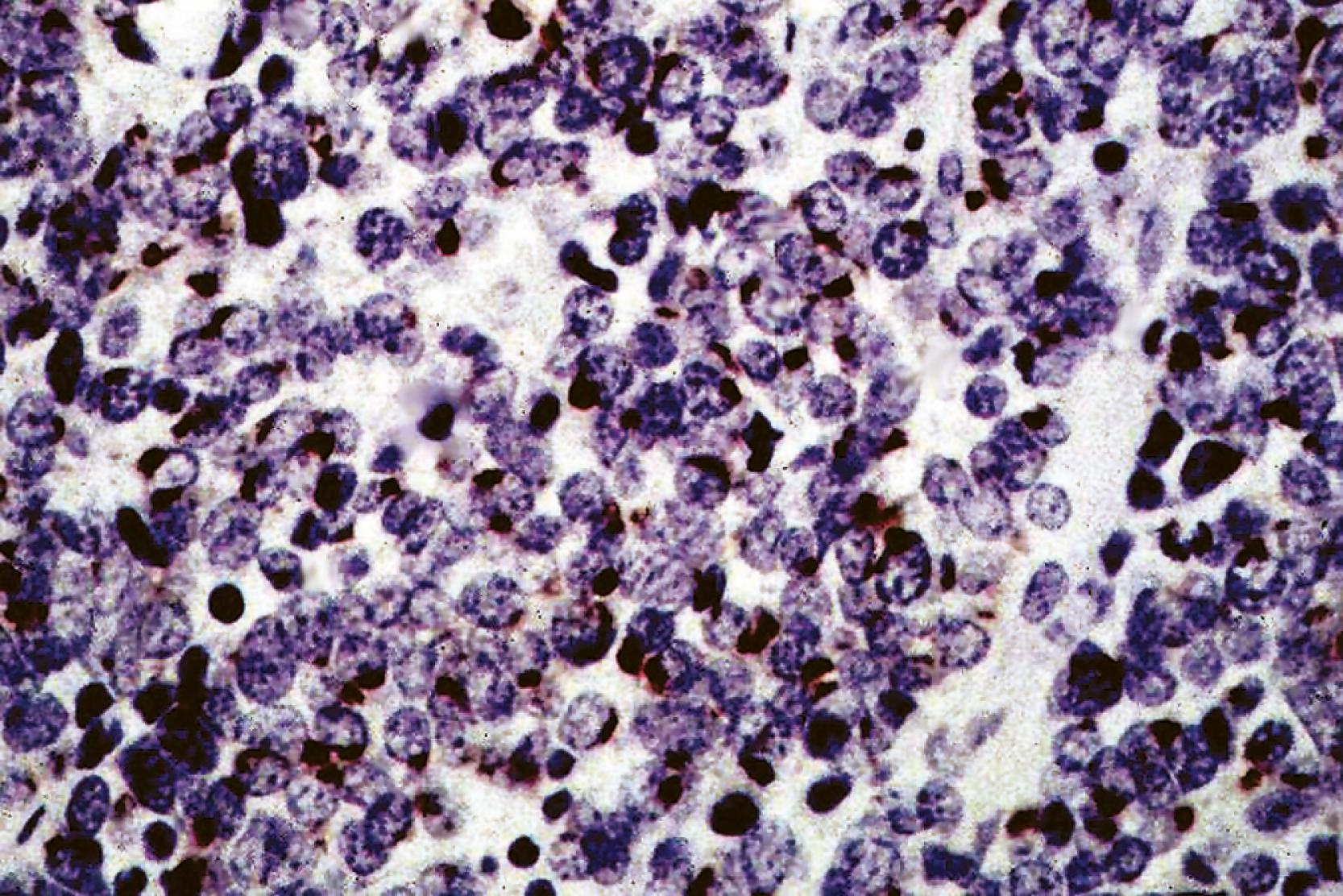
Histologic features cannot absolutely distinguish MCC from metastatic small cell neuroendocrine carcinomas. Nonetheless, clinical pathologic correlation and a battery of antibodies to CEA, CK20, NFP, and thyroid transcription factor 1 (TTF-1) are useful in this context. Bronchogenic small cell neuroendocrine carcinoma typically shows reactivity for CEA,TTF-1 ( Fig. 13.14 ), or both, but it lacks CK20 and NFP. , Conversely, CK20 and NFP are often expressed by MCC and are generally absent in extracutaneous neuroendocrine carcinomas. A more recently described antigen, the Merkel cell polyomavirus (MCPyV) seen in many MCCs, has not been reported to be expressed in other neuroendocrine carcinomas.
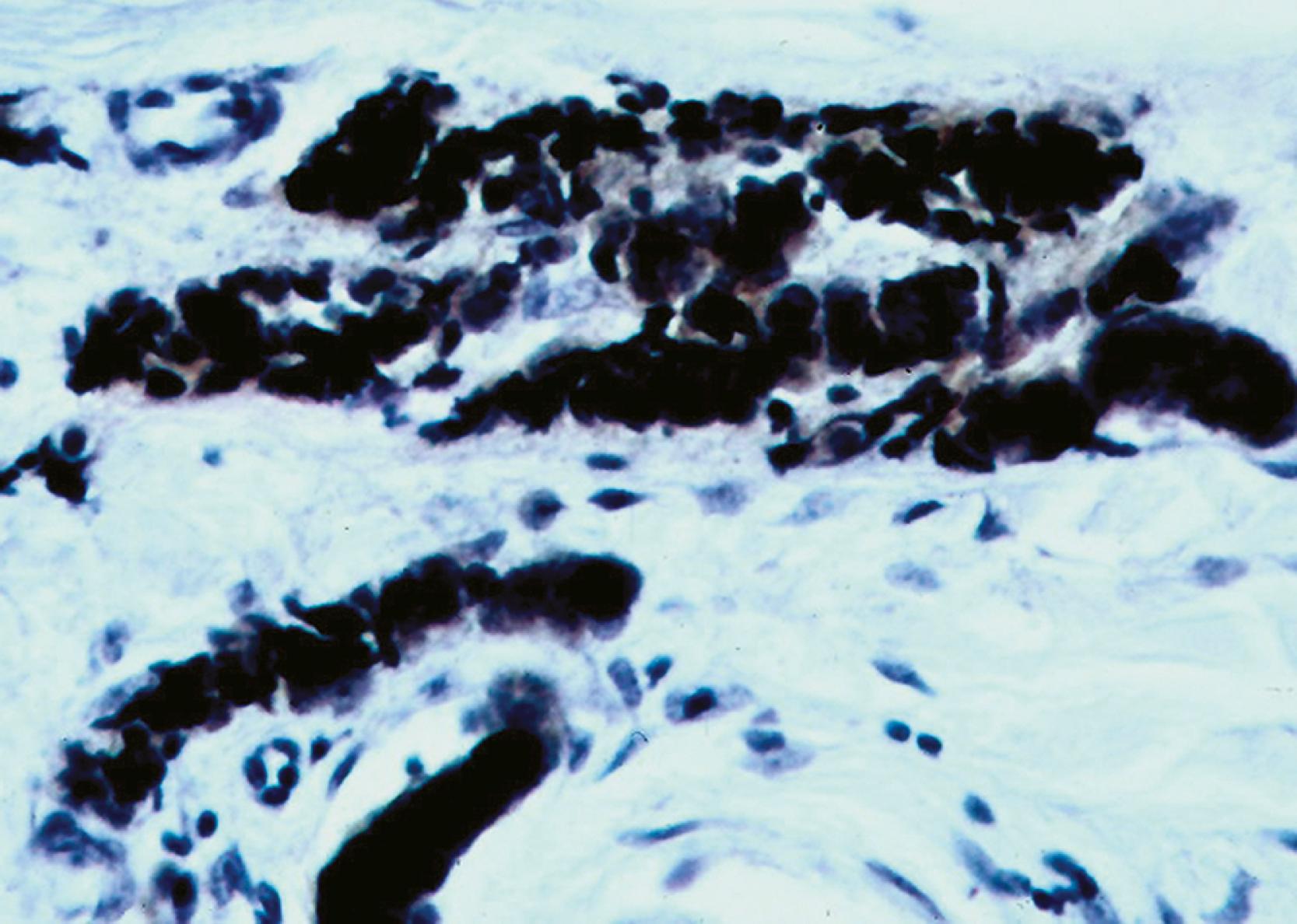
Another differential diagnosis is with Ewing sarcoma/primitive neuroectodermal tumor (ES/PNET) primary or metastatic to the skin. , Although these tumor types share possible
Merkel cell carcinoma is positive for CK20 (dot-like pattern), CD15, CD56, CD57, neurofilament protein, chromogranin (the latter two also with dot-like pattern), and various neuroendocrine hormones. Rare cases express TTF-1, but such positivity, when present in MCC, is only focal. Polyoma virus is seen in a number of cutaneous MCCs.
Pulmonary small cell carcinoma metastatic in skin is CEA- and TTF-1-positive and CK20-negative.
In cutaneous ES/PNET, CK is focal (if positive at all), vimentin is positive, and CK20 and EMA are negative.
reactivity for CD56, CD57, FLI-1, synaptophysin, and CD99 ( Fig. 13.15A ), expression of pankeratin and CK20 is unusual in PNETs.
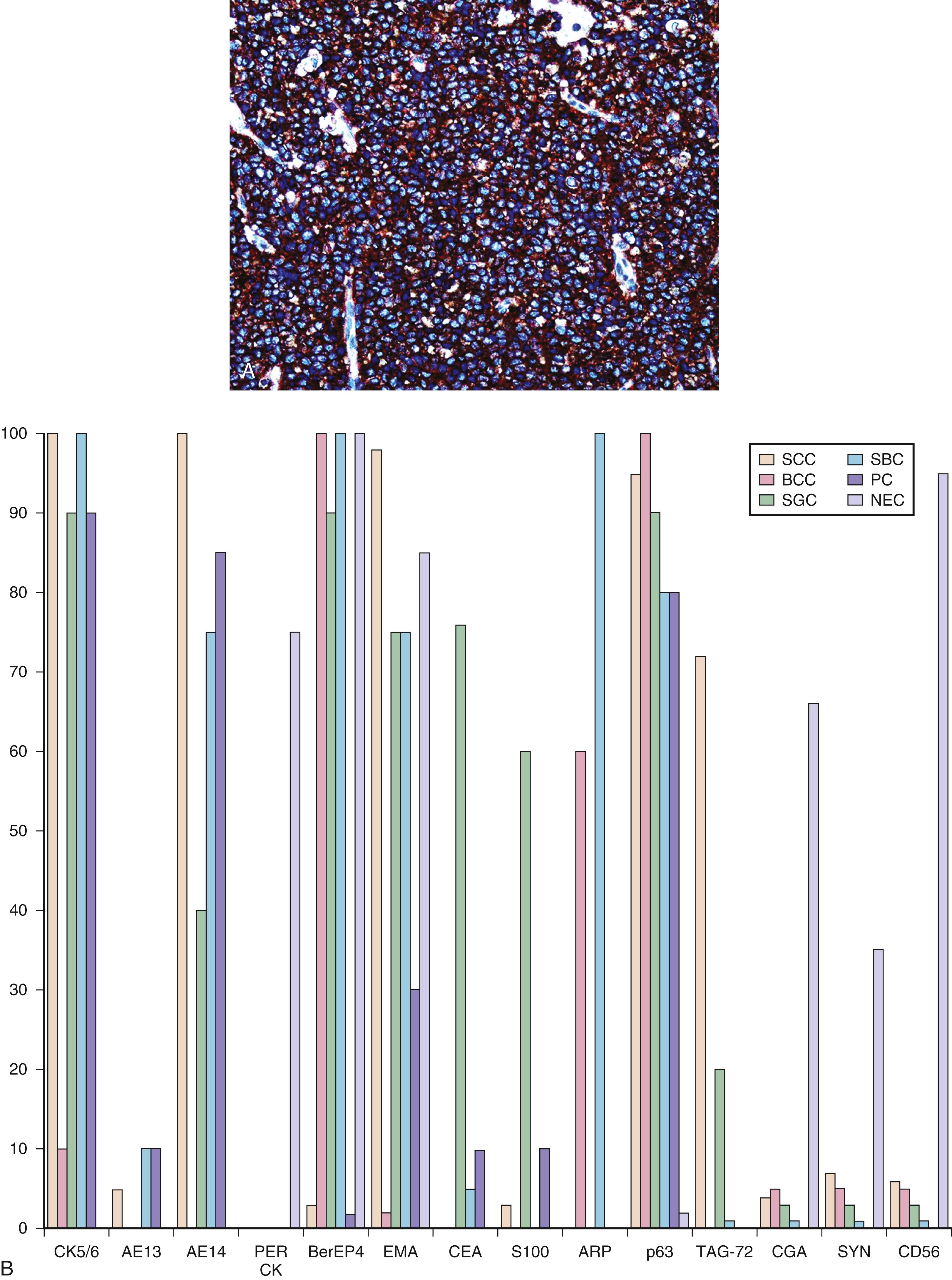
MCC may also be mistaken for BCC. The potential for endocrine differentiation in the latter tumor was discussed earlier, but it is never as diffuse or global as that seen in MCC. Moreover, CK20 and EMA are not seen in BCC, in contrast with MCC, and the perinuclear keratin reactivity pattern of MCC is absent in BCC.
Zembowicz and colleagues have described an endocrine mucin-producing sweat gland carcinoma. That lesion histologically resembles mucinous carcinoma, rather than MCC, and it is immunoreactive for estrogen and progesterone receptor proteins (PRPs), in addition to endocrine markers. Expected immunoreactivity patterns in various cutaneous epithelial tumors are shown in Fig. 13.15B .
Given the histologic diversity of T-cell and B-cell lymphoid and histiocytic proliferations of skin, complete consideration of each of those conditions is well beyond the scope of this chapter. Indeed, detailed information on the immunohistology of hematopoietic lesions in general is provided in other chapters in this book. Definitive determinations of cell lineage in several of these disorders are often difficult or impossible to make if only their morphologic and clinical attributes are considered. This discussion emphasizes selected aspects of immunophenotyping that have special relevance to hematologic lesions of the skin.
Become a Clinical Tree membership for Full access and enjoy Unlimited articles
If you are a member. Log in here